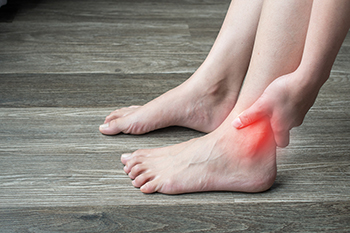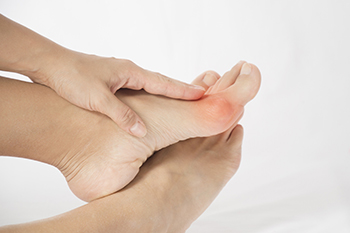Items filtered by date: April 2023
Heel Pain Can Be Treated!
Why Are the Feet Ticklish?

Many individuals may wonder why their feet are often so ticklish and sensitive. The answer is slightly complicated. Essentially, the feet have a significantly high amount of nerve endings. In fact, there are approximately 8,000 nerve endings throughout the feet. Importantly, in each of these nerve endings are receptors for touch and other sensations. The distance between the nerve ending and the outside of the skin is sometimes very small. Therefore, the feet can often be more ticklish than other parts of the body. Interestingly, the degree to which one is ticklish can often vary from person to person. It is important to note that the ticklish sensation itself is thought to be a kind of involuntary response to stimuli. If you want to learn more about what makes the feet ticklish, it is suggested that you contact a podiatrist for additional information and treatment options.
If you have any concerns about your feet, contact Philip Hahn, DPM from Advanced Foot & Ankle Center. Our doctor can provide the care you need to keep you pain-free and on your feet.
Biomechanics in Podiatry
Podiatric biomechanics is a particular sector of specialty podiatry with licensed practitioners who are trained to diagnose and treat conditions affecting the foot, ankle and lower leg. Biomechanics deals with the forces that act against the body, causing an interference with the biological structures. It focuses on the movement of the ankle, the foot and the forces that interact with them.
A History of Biomechanics
- Biomechanics dates back to the BC era in Egypt where evidence of professional foot care has been recorded.
- In 1974, biomechanics gained a higher profile from the studies of Merton Root, who claimed that by changing or controlling the forces between the ankle and the foot, corrections or conditions could be implemented to gain strength and coordination in the area.
Modern technological improvements are based on past theories and therapeutic processes that provide a better understanding of podiatric concepts for biomechanics. Computers can provide accurate information about the forces and patterns of the feet and lower legs.
Understanding biomechanics of the feet can help improve and eliminate pain, stopping further stress to the foot.
If you have any questions please feel free to contact our office located in Texarkana, TX . We offer the newest diagnostic and treatment technologies for all your foot and ankle needs.
Ankle Pain Without Injury

One can have ankle pain even if they have not injured their ankle. This can occur from some underlying health conditions, such as autoimmune diseases or arthritis, and from unrelated foot ailments. Osteoarthritis, the most common form of arthritis, is when the cartilage between two bones erodes over time. Without cartilage in the ankle, the bones rub together and there can be pain and stiffness. Other types of arthritis, including rheumatoid arthritis, reactive arthritis, and gout are other conditions that can cause inflammation and leave the ankle feeling tender as well. Lupus and scleroderma are examples of autoimmune diseases that can have the same side effects. Of course, other foot and ankle ailments, like fallen arches and Achilles tendonitis can also cause ankle pain. Treatment depends on the root cause of the ankle pain. If you have such pain and there is no obvious reason for it, it is suggested that you see a podiatrist for a correct diagnosis and care regime.
Ankle pain can have many different causes and the pain may potentially be serious. If you have ankle pain, consult with Philip Hahn, DPM from Advanced Foot & Ankle Center. Our doctor will assess your condition and provide you with quality foot and ankle treatment.
Ankle pain is any condition that causes pain in the ankle. Due to the fact that the ankle consists of tendons, muscles, bones, and ligaments, ankle pain can come from a number of different conditions.
Causes
The most common causes of ankle pain include:
- Types of arthritis (rheumatoid, osteoarthritis, and gout)
- Ankle sprains
- Broken ankles
- Achilles tendinitis
- Achilles tendon rupture
- Stress fractures
- Tarsal tunnel syndrome
- Plantar fasciitis
Symptoms
Symptoms of ankle injury vary based upon the condition. Pain may include general pain and discomfort, swelling, aching, redness, bruising, burning or stabbing sensations, and/or loss of sensation.
Diagnosis
Due to the wide variety of potential causes of ankle pain, podiatrists will utilize a number of different methods to properly diagnose ankle pain. This can include asking for personal and family medical histories and of any recent injuries. Further diagnosis may include sensation tests, a physical examination, and potentially x-rays or other imaging tests.
Treatment
Just as the range of causes varies widely, so do treatments. Some more common treatments are rest, ice packs, keeping pressure off the foot, orthotics and braces, medication for inflammation and pain, and surgery.
If you have any questions, please feel free to contact our office located in Texarkana, TX . We offer the newest diagnostic and treatment technologies for all your foot care needs.
Foot Care Tips for Seniors

Healthy feet allow seniors to stay independent longer. Foot care is essential to reaching this goal and keeping senior feet comfortable and healthy. Since the feet take one through a lifetime of mobility, it stands to reason that aging feet need extra attention. Over time, feet become flatter and wider. The fatty padding on the foot naturally wears down, and the bones and joints are exposed to more wear and tear. Simple foot problems, like blisters, can interfere with mobility and balance in older adults. More serious foot conditions, like ingrown toenails, sprains, or fractures, can increase the risk of falling and result in various health conditions. Simple foot care tips to help keep feet as healthy as possible include washing, drying, and moisturizing the feet daily, trimming nails straight across, and examining the feet for abnormalities, such as sores. Wearing properly fitted shoes that are sturdy and low-heeled is recommended. If you are an older person or taking care of one, it is suggested that you include a podiatrist among the doctors you visit to monitor any problems brewing and continue caring for the feet.
Proper foot care is something many older adults forget to consider. If you have any concerns about your feet and ankles, contact Philip Hahn, DPM from Advanced Foot & Ankle Center. Our doctor can provide the care you need to keep you pain-free and on your feet.
The Elderly and Their Feet
As we age we start to notice many changes in our body, but the elder population may not notice them right away. Medical conditions may prevent the elderly to take notice of their foot health right away. Poor vision is a lead contributor to not taking action for the elderly.
Common Conditions
- Neuropathy – can reduce feeling in the feet and can hide many life-threatening medical conditions.
- Reduced flexibility – prevents the ability of proper toenail trimming, and foot cleaning. If left untreated, it may lead to further medical issues.
- Foot sores – amongst the older population can be serious before they are discovered. Some of the problematic conditions they may face are:
- Gouging toenails affecting nearby toe
- Shoes that don’t fit properly
- Pressure sores
- Loss of circulation in legs & feet
- Edema & swelling of feet and ankles
Susceptible Infections
Diabetes and poor circulation can cause general loss of sensitivity over the years, turning a simple cut into a serious issue.
If you have any questions please feel free to contact our office located in Texarkana, TX . We offer the newest diagnostic and treatment technologies for all your foot and ankle needs.
How Can I Prevent a Bunion?

Bunions are a particular kind of bony bump that can form on the outside of the joint of the big toe or small pinky toe. It is important to note that some types of bunions can cause pain in individuals, while others do not. In this sense, a bunion can be a cosmetic issue for some patients. There are several steps that a patient can consider taking to prevent the formation of bunions. For example, an individual can be mindful of the shoes that they are wearing. Particularly tight shoes can lead to bunions developing. Instead, an individual can be sure to wear shoes that are spacious and comfortable. Secondly, an individual might be able to prevent the development of bunions by doing what they can to stop overpronation. Importantly, overpronation can occur when the foot rolls inward. Orthotics may be used to correct this. If you are someone that is struggling with bunions, it is suggested that you contact a podiatrist today for treatment.
If you are suffering from bunions, contact Philip Hahn, DPM of Advanced Foot & Ankle Center. Our doctor can provide the care you need to keep you pain-free and on your feet.
What Is a Bunion?
A bunion is formed of swollen tissue or an enlargement of boney growth, usually located at the base joint of the toe that connects to the foot. The swelling occurs due to the bones in the big toe shifting inward, which impacts the other toes of the foot. This causes the area around the base of the big toe to become inflamed and painful.
Why Do Bunions Form?
Genetics – Susceptibility to bunions are often hereditary
Stress on the feet – Poorly fitted and uncomfortable footwear that places stress on feet, such as heels, can worsen existing bunions
How Are Bunions Diagnosed?
Doctors often perform two tests – blood tests and x-rays – when trying to diagnose bunions, especially in the early stages of development. Blood tests help determine if the foot pain is being caused by something else, such as arthritis, while x-rays provide a clear picture of your bone structure to your doctor.
How Are Bunions Treated?
- Refrain from wearing heels or similar shoes that cause discomfort
- Select wider shoes that can provide more comfort and reduce pain
- Anti-inflammatory and pain management drugs
- Orthotics or foot inserts
- Surgery
If you have any questions, please feel free to contact our office located in Texarkana, TX . We offer the newest diagnostic and treatment technologies for all your foot care needs.





